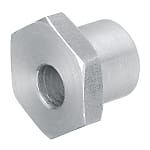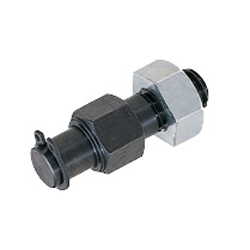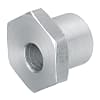(!)NOTE : Windows 7 users won’t be able to use some latest features of eCatalog/WOS since Microsoft is ending support for Windows 7 on 14 Jan, 2020. Please upgrade your system for uninterrupted services.
- Notice of End of Sales for Economy Series Pneumatic Equipment Category. More information.
Bearings with Resin(Outer Ring Type:Related Components)
|
Outer Ring Type
|
|
|---|---|
Brand |
|
| CAD |
|
| Days to Ship |
|
2 items
- Sort By
-
You can add up to 6 items per a category to the compare list.

MISUMI
By using an eccentric bush when fixing the roller, the position of the roller can be easily adjusted.
The outer diameter tolerance of the bearing insertion part is G6 tolerance. Compatible with Misumi's silicone and urethane molded bearings.- Volume Discount
Outer Ring Type Outer Dia. D(Ø) Outer Ring Material Mounting Type Width B(mm) Operating/Environmental Requirement Inner Dia. d1(Ø) Bearing Material Tightening Method Screw Nominal M(mm) Allowable Load Range(N) Allowable Load(N) Shaft Dia. d2(Ø) Related Components - - Hole - Standard - - - - - - - From: ₹ 353.25 Days to Ship: 6 Day(s) or more  6 Day(s) or more
6 Day(s) or more
-
You can add up to 6 items per a category to the compare list.

Urethane Molded Bearing Shafts
MISUMI
This shaft is compatible with MISUMI's silicone and urethane molded bearings. Nuts and retaining rings are also included as a set, making selection easy.
- Volume Discount
Outer Ring Type Outer Dia. D(Ø) Outer Ring Material Mounting Type Width B(mm) Operating/Environmental Requirement Inner Dia. d1(Ø) Bearing Material Tightening Method Screw Nominal M(mm) Allowable Load Range(N) Allowable Load(N) Shaft Dia. d2(Ø) Related Components - - Screw - Standard - - - - - - - From: ₹ 281.82 Days to Ship: 8 Day(s) or more  8 Day(s) or more
8 Day(s) or more
| Brand |
|---|
| Product Series |
| CAD |
| From |
| Days to Ship |
| Outer Ring Type |
| Outer Dia. D(Ø) |
| Outer Ring Material |
| Mounting Type |
| Width B(mm) |
| Operating/Environmental Requirement |
| Inner Dia. d1(Ø) |
| Bearing Material |
| Tightening Method |
| Screw Nominal M(mm) |
| Allowable Load Range(N) |
| Allowable Load(N) |
| Shaft Dia. d2(Ø) |
You can add up to 6 items per a category to the compare list. | You can add up to 6 items per a category to the compare list. | |
| Brand | MISUMI | MISUMI |
| Product Series | ||
| CAD |
|
|
| From | ₹ 353.25 | ₹ 281.82 |
| Days to Ship | 6 Day(s) or more | 8 Day(s) or more |
| Outer Ring Type | Related Components | Related Components |
| Outer Dia. D(Ø) | - | - |
| Outer Ring Material | - | - |
| Mounting Type | Hole | Screw |
| Width B(mm) | - | - |
| Operating/Environmental Requirement | Standard | Standard |
| Inner Dia. d1(Ø) | - | - |
| Bearing Material | - | - |
| Tightening Method | - | - |
| Screw Nominal M(mm) | - | - |
| Allowable Load Range(N) | - | - |
| Allowable Load(N) | - | - |
| Shaft Dia. d2(Ø) | - | - |
Loading...
Configure
Specification/Dimensions
-
Outer Dia. D(Ø)
-
Outer Ring Material
- Urethane
- Nylon
- Polyacetal
- Silicone
- Stainless Steel
- Steel
- UHMW
-
Mounting Type
-
 Hole
Hole -
 Shaft
Shaft -
 Screw
Screw
-
-
Width B(mm)
-
Operating/Environmental Requirement
- Standard
- Antistatic Property
- High Load Capacity
- Abrasion Resistance
- Durability
- Dust Resistance
- Corrosion Resistance
-
Inner Dia. d1(Ø)
-
Bearing Material
-
Tightening Method
-
Screw Nominal M(mm)
-
Allowable Load Range(N)
-
Allowable Load(N)
-
Shaft Dia. d2(Ø)
Related Categories to Bearings with Resin
-
- Belt Conveyors, Plastic Chain Conveyors
- Roller Conveyors
- Wheel Conveyors, Roller Carriers
- Screws
- Accessories for Conveyor
- Flat Belts, Pulleys
- Conveyer Timing Belts
- Plastic Modular Belts
- Conveyer Chains, Sprockets
- Plastic Chains
- Rollers
- Industrial Brushes
- Bearings with Resin
- Ball Rollers
- Elevators
- Frames for Conveyors
-
FAQ about Conveyor Bearings (Bearings with Resin)
- Question: What is Maximum allowable load for Engineered Plastic Bearings?
- Answer: Please see more details at Maximum allowable load of Ball bearings.
- Question: Can I order single piece for thread part of Engineered Plastic Bearings?
- Answer: Thread part of Engineered Plastic Bearings is not available in single piece.
- Question: What are bearings with resin and how are they used in automation components?
- Answer: Bearings with resin are a type of bearing that incorporates engineered plastics, such as polyacetal (POM) or silicone rubber, in their construction. They are used in automation components for various such as transportation rollers, guide rollers, automatic sorting equipment (sorters), conveyance equipment, chain conveyor equipment and so on
- Question: What types of materials are typically used in the outer rings of resin bearings?
- Answer: The outer rings of resin bearings are typically made from various materials, including
1. Acetal resin is a high-performance engineering thermoplastic known for its excellent mechanical properties, including high stiffness, low friction, and resistance to wear and tear.
2. Polyacetal offers similar properties such as high stiffness, low friction, and wear resistance. Polyacetal resin bearings provide similar performance benefits as acetal resin bearings and are commonly used in automation components where these properties are required.
3. Antistatic polyacetal bearings are suitable for use in automation components where electrostatic discharge (ESD) protection is necessary to prevent damage to sensitive electronic equipment - Question: How do I determine the right outer diameter and width for a resin bearing?
- Answer: To determine the appropriate outer diameter and width for a resin bearing, several factors must be considered, including the load capacity, speed, and operating conditions of the application. The outer diameter of a resin bearing can be calculated using the formula D = d + 2B,
D represents the outer diameter,
d denotes the inner diameter,
B stands for the width of the bearing.
The width of the bearing can be determined based on the load capacity and speed of the application, ensuring it is adequate to support the load and prevent excessive wear. Additionally, the width of the bearing can be adjusted according to the operating conditions of the application, such as temperature, humidity, and exposure to chemicals. - Question: What are the key features to look for in high-quality resin bearings?
- Answer: Bearings with resin require high-quality materials and low friction; moreover, they are known for durability in working environments. Precise manufacturing ensures accurate dimensions and proper fit, crucial for smooth operation. They must handle loads effectively, resist corrosion, and remain stable across temperature variations. Effective sealing guards against contamination, preserving performance integrity. Additionally, they should demand minimal maintenance, reducing downtime and costs.
- Question: How do resin bearings compare to traditional metal bearings in terms of performance?
- Answer: Bearings with resin and traditional metal bearings each offer distinct performance characteristics:
1. Friction and Wear: Resin bearings typically have lower friction coefficients, reducing energy consumption and heat generation. Metal bearings may excel in wear resistance, especially under high-load or abrasive conditions.
2. Corrosion Resistance: Resin bearings inherently resist corrosion, making them suitable for moist or chemically exposed environments. Metal bearings might require additional coatings for similar protection.
3. Weight: Resin bearings are lighter than metal ones, advantageous in weight-sensitive applications. Metal bearings, though heavier, may offer higher load capacities.
4. Load Capacity: Metal bearings generally have higher load capacities than resin bearings, making them preferable for heavy-duty applications.
5. Temperature Range: Metal bearings often tolerate wider temperature ranges, while resin bearings may soften or degrade at high temperatures. - Question: What are the advantages of using urethane or silicone in resin bearings?
- Answer: Using urethane or silicone in resin bearings provides several advantages. These materials offer excellent flexibility, resilience, and vibration absorption, reducing the risk of damage to bearings and components. They also exhibit low friction properties, ensuring smooth movement and minimal wear. Additionally, urethane and silicone contribute to noise reduction during operation. Their resistance to chemicals and stability across a wide temperature range enhance durability and reliability in diverse environments.





















How can we improve?
How can we improve?
Thank you for your time.
Your feedback is essential for our continuous improvement
Privacy Policy
Thank you for your cooperation.
Thank you for your time.
Your feedback is essential for our continuous improvement
Please use the inquiry form.
Privacy Policy